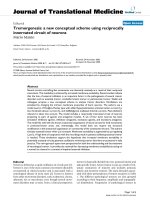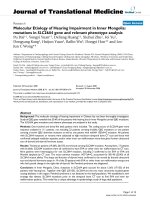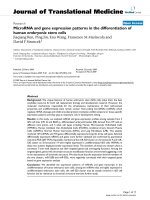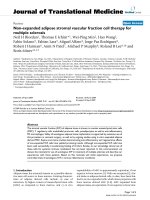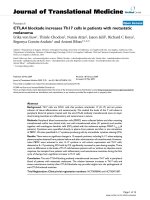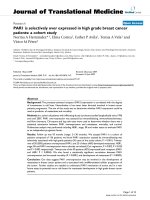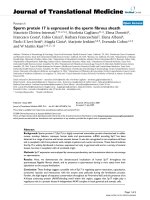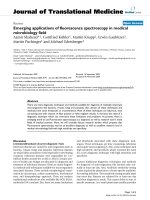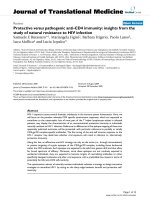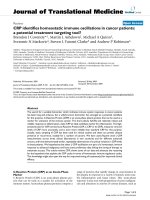báo cáo hóa học: " Apolipoprotein E-specific innate immune response in astrocytes from targeted replacement mice" pptx
Bạn đang xem bản rút gọn của tài liệu. Xem và tải ngay bản đầy đủ của tài liệu tại đây (394.94 KB, 6 trang )
BioMed Central
Page 1 of 6
(page number not for citation purposes)
Journal of Neuroinflammation
Open Access
Research
Apolipoprotein E-specific innate immune response in astrocytes
from targeted replacement mice
Izumi Maezawa
1
, Nobuyo Maeda
2
, Thomas J Montine
1
and
Kathleen S Montine*
1
Address:
1
Department of Pathology, University of Washington, Seattle, WA, USA and
2
Department of Pathology, University of North Carolina,
Chapel Hill, NC, USA
Email: Izumi Maezawa - ; Nobuyo Maeda - ;
Thomas J Montine - ; Kathleen S Montine* -
* Corresponding author
Abstract
Background: Inheritance of the three different alleles of the human apolipoprotein (apo) E gene
(APOE) are associated with varying risk or clinical outcome from a variety of neurologic diseases.
ApoE isoform-specific modulation of several pathogenic processes, in addition to amyloid β
metabolism in Alzheimer's disease, have been proposed: one of these is innate immune response
by glia. Previously we have shown that primary microglia cultures from targeted replacement (TR)
APOE mice have apoE isoform-dependent innate immune activation and paracrine damage to
neurons that is greatest with TR by the ε4 allele (TR APOE4) and that derives from p38 mitogen-
activated protein kinase (p38MAPK) activity.
Methods: Primary cultures of TR APOE2, TR APOE3 and TR APOE4 astrocytes were stimulated
with lipopolysaccharide (LPS). ApoE secretion, cytokine production, and nuclear factor-kappa B
(NF-κB) subunit activity were measured and compared.
Results: Here we showed that activation of primary astrocytes from TR APOE mice with LPS led
to TR APOE-dependent differences in cytokine secretion that were greatest in TR APOE2 and that
were associated with differences in NF-κB subunit activity.
Conclusion: Our results suggest that LPS activation of innate immune response in TR APOE glia
results in opposing outcomes from microglia and astrocytes as a result of TR APOE-dependent
activation of p38MAPK or NF-κB signaling in these two cell types.
Background
Humans are different from other mammals in that we
have 3 common alleles of the apolipoprotein E gene
(APOE): the ε2 (APOE2), ε3 (APOE3), and ε4 (APOE4)
alleles [1]. Numerous genetic studies have associated
inheritance of APOE4 with increased risk, earlier onset, or
poorer clinical outcome for a number of neurodegenera-
tive diseases, including Alzheimer's disease (AD), Parkin-
son's disease (PD), amyotrophic lateral sclerosis (ALS),
traumatic brain injury, and HIV-encephalitis [2-10]. At
least for AD, inheritance of APOE2 is associated with
apparent neuroprotection, perhaps related to delayed
onset of illness by many years [11]. While apoE isoforms
play a role in the metabolism of beta amyloid (Aβ) pep-
Published: 07 April 2006
Journal of Neuroinflammation 2006, 3:10 doi:10.1186/1742-2094-3-10
Received: 08 March 2006
Accepted: 07 April 2006
This article is available from: />© 2006 Maezawa et al; licensee BioMed Central Ltd.
This is an Open Access article distributed under the terms of the Creative Commons Attribution License ( />),
which permits unrestricted use, distribution, and reproduction in any medium, provided the original work is properly cited.
Journal of Neuroinflammation 2006, 3:10 />Page 2 of 6
(page number not for citation purposes)
tides and thereby may modulate the risk of developing AD
[12], the influence of inheriting different APOE alleles
extends well beyond diseases thought to involve Aβ pep-
tide-mediated neurotoxicity, as noted above. For this rea-
son, other apoE-isoform specific mechanisms likely exist
to explain the apparent influence of APOE alleles on such
a broad spectrum of neurologic diseases; indeed, several
have been proposed including synaptic stabilization, bio-
logically active proteolytic fragments of apoE, anti-oxi-
dant activity, and nitric oxide (NO) production [13-16].
ApoE also has an immune modulatory function, at least in
the peripheral adaptive immune response to some bacte-
ria and viruses [17]. We have recently shown that micro-
glia from mice with targeted replacement (TR) of the
mouse apoE gene with the coding sequences of human
APOE alleles activated with LPS display an apoE isoform-
specific innate immune response and result in apoE iso-
form-specific paracrine damage to neurons, both of which
are dependent on p38 mitogen-activated protein kinase
(p38MAPK) -mediated signaling.
One commonly used approach to investigate selectively
innate immune response in neurodegeneration is to use a
specific stimulus, lipopolysaccharide (LPS) [18-25]. LPS
specifically activates CD14/Toll-like receptor (TLR) 4 co-
receptors with subsequent increased gene transcription
mediated through a bifurcated pathway that is dependent
on both nuclear factor-kappa B (NF-κB) and p38MAPK
signaling [26,27]. Indeed, LPS activation of CD14/TLR4
co-receptors on microglia leads to indirect damage to neu-
rons and oligodendroglia in culture and in vivo [22,28-
30]. Moreover, a role for CD14/TLR4 co-receptors is now
understood to extend well beyond endotoxemia, as they
are important in innate immune response to several
endogenous ligands [31]. Indeed, CD14 binds Aβ fibrils
and is responsible for most of Aβ–stimulated microglial-
mediated neurotoxicity [32]. In addition, peptides and
neoantigens expressed by apoptotic cells also activate this
pathway [33]. Here we tested the hypothesis that innate
immune response from CD14/TLR4 activation would
show isoform-specific differences in primary cultures of
astrocytes from TR APOE mice.
Methods
Materials
Cell culture solutions and supplies were from GIBCO
(Grand Island, NY). Poly-ornithine (0.01%) was from
Sigma (St. Louis, MO). 4–15% SDS-polyacrylamide gels
were from BioRad (Hercules, CA). LPS and the NO assay
kit were from Calbiochem (La Jolla, CA). Primary anti-
bodies used were polyclonal anti-human apoE antibody
from Dako Corporation (Carpinteria, CA) and polyclonal
anti-glial fibrillary astrocytic protein (GFAP) antibody
from Novus Biologicals (Littleton, CO). The NF-κB tran-
scription factor assay kit and purified human HDL were
from Chemicon International (Temecula, CA)
Mice
Homozygous APOE2, APOE3 and APOE4 targeted
replacement (TR) mice 'humanized' at apoE were devel-
oped by Dr. Maeda and colleagues [34,35]. Briefly,
human APOE genomic fragments were used to replace
mouse apoE via homologous recombination. All three
lines of TR APOE mice contain chimeric genes consisting
of mouse 5' regulatory sequences continuous with mouse
exon 1 (noncoding) followed by human exons (and
introns) 2–4 [34]. These mice were backcrossed greater
than six generations to C67BL/6 genetic background. Mice
were housed in an ALAC-approved vivarium and methods
approved by a University of Washington International
Use and Care of Animals (IACUC) Committee.
Astrocyte cultures
Primary cultures of 1-day-old mouse cerebral cortical
astrocytes were prepared according to the method of
Gebicke-Haerter, et al. [36]. Confluent cultures were used
on the 7
th
day in vitro (DIV). Our preparations were ≥ 93%
pure for astrocytes, as demonstrated by glial fibrillary
acidic protein (GFAP) antibody. Astrocytes were exposed
to LPS in serum-free medium at a final concentration of
100 ng/ml (20 ng/10
5
cells). Vehicle control for LPS expo-
sure was PBS.
Western blot analysis
Conditioned (serum-free) medium was removed from
astrocyte cultures following LPS or vehicle exposure and
centrifuged at 13,000 × g for 2 min at 4°C to remove cell
debris. Equal volumes of conditioned media were diluted
with 6X sample buffer (0.35 M Tris, 30% glycerol, 10%
SDS, 0.93 g DTT, 1.2 mg bromophenol blue), heated to
95°C for 5 min, subjected to SDS PAGE, transferred to
PVDF membranes, and analyzed and quantified as previ-
ously described [37]. Anti-human apoE (Dako) was used
at 1:2000 dilution. Secondary antibody was HRP-conju-
gated anti-rabbit (1:3000).
NO detection
NO levels in conditioned media following incubation
with LPS or vehicle were measured using a colorimetric
NO assay kit (Calbiochem) where nitrate is first converted
to nitrite by the NADH-dependent nitrate reductase, fol-
lowed by nitrite measurement using the Griess Reagent.
Cytokine measurements
Conditioned medium following incubation with LPS or
vehicle was screened for cytokines with an array method,
and selected cytokines further quantified individually by
sandwich ELISAs. The bead-based Liquichip™ Mouse 10-
Cytokine Kit (Qiagen Inc, Valencia CA) was used to simul-
Journal of Neuroinflammation 2006, 3:10 />Page 3 of 6
(page number not for citation purposes)
taneously screen conditioned media for the following
cytokines: GM-CSF, interferon (INF)-γ, interleukin (IL)-
1β, -2, -4, -5, -6, -10, -12, and tumor necrosis factor (TNF)
–α. This kit uses cytokine antibodies immobilized on Liq-
uiChip™ beads with distinct bead codes, which are added
to conditioned media samples. Bead-bound cytokines are
detected using a mixture of biotinylated cytokine-specific
monoclonal antibodies and Streptavidin-PE. The specific
bead code assigned to each of the 10 cytokines enables
their unambiguous identification and quantification by a
Luminex 100 X-Map reader using Qiagen software. Next,
IL-6, IL-1β, and TNF-α from conditioned media were sep-
arately quantified by sandwich ELISAs using DuoSet
ELISA development kits for each cytokine (R&D Systems,
Minneapolis, MN).
NF-
κ
B activity
NF-κB activity following incubation with LPS or vehicle
was measured using an NF-κB transcription factor assay
kit from Chemicon International. Briefly, cells were rinsed
with PBS, lysed in Buffer A (10 mM HEPES (pH7.9), 1.5
mM MgCl
2
, 10 mM KCl, 0.5 mM DTT, 0.1% Triton X-100
and protease inhibitor cocktail), and a nuclear extract pre-
pared in Buffer B (20 mM HEPES (pH 7.9), 1.5 mM
MgCl
2
, 0.42 M NaCl, 0.2 mM EDTA. 0.5 mM DTT, 1.0%
Igepal CA-630, 25% (v/v) glycerol, and protease inhibitor
cocktail). Double-stranded biotinylated oligonucleotide
containing the flanked consensus sequence for NF-κB was
mixed with the nuclear extract and the mixture immobi-
lized on a streptavidin-coated chemiluminescent plate,
followed by immunologic detection of the bound NF-κB
transcription factor subunits p50 and 065.
Results
We have recently reported that LPS activation of TR APOE
glial-wt neuron mixed cultures for 24 hours results in
apoE isoform-specific paracrine damage to neurons [30].
For activated microglia, TR APOE4 is more neurotoxic
than TR APOE2 or APOE3. For activated astrocytes, which
produce much less neurotoxicity than microglia, both TR
APOE4 and TR APOE3 are mildly damaging to neurons,
while TR APO2 shows no neurotoxic effect. In this previ-
ous work, we pursued apoE-isoform specific mechanisms
in LPS-activated microglia and showed that these were
p38MAPK-dependent. Here, we pursued the basis of apoE
isoforms-specific differences in LPS activation of astro-
cytes from these TR mice.
We first showed that there was no difference among the
three TR APOE astrocytes in the amount of secreted apoE
following LPS exposure for up to 24 hours (Figure 1), in
agreement with our findings for microglia [30]. We also
determined that similar to microglia, there was no differ-
ence in medium nitrate plus nitrite levels (a measure of
NO secretion) compared to wild type (wt) at 12 or 24
hours after LPS exposure (P > 0.05), although we did
observe increased medium nitrate plus nitrite levels in TR
APOE4 (205 ± 41 % of wt) but not TR APOE2 (116 + 15%
of wt) astrocytes 72 hours after LPS incubation. As with
microglia, this temporal mismatch suggests increased NO
secretion by TR APOE4 lies distal to the processes under-
lying the TR-APOE isoform-specific differences in astro-
cyte-mediated neurotoxicity seen within 24 hours of LPS
incubation [30].
Previously, we observed TR APOE-dependent differences
in cytokine secretion by microglia in response to LPS
exposure [30]. Here we measured cytokine secretion in
response to LPS in the three TR APOE astrocyte cultures.
We screened for changes in medium cytokine concentra-
tions using the LiquiChip™ Mouse 10-Cytokine assay and
a Luminex 100 X-Map reader that simultaneously deter-
mines 10 mouse cytokines in medium from TR APOE
astrocytes. The cytokines quantified were GM-CSF, INF-γ,
IL-1β, IL-2, IL-4, IL-5, IL-6, IL-10, IL-12, and TNF-α. Only
IL-6 and TNF-α changed significantly following LPS expo-
sure for 12 hr; IL-1β was near the limit of detection for this
assay. The magnitude of induction for these cytokines was
TR APOE-dependent with IL-6 and TNF-α concentrations
following the gradient of TR APOE2 > TR APOE3 > TR
APOE4. We confirmed our IL-6 and TNF-α findings with
individual ELISAs and extended our analysis to IL-1β,
since many others have shown it to be overexpressed and
secreted from LPS-stimulated glia; TR APOE-dependence
ApoE secretion following LPS stimulationFigure 1
ApoE secretion following LPS stimulation. Mouse cer-
ebral primary astrocyte cultures were incubated in serum-
free medium with 100 ng/ml LPS or vehicle (PBS) for 24
hours. 20 µl of conditioned medium was collected at 3, 6, 12,
and 24 hrs after exposure, spun briefly, mixed with 4 µl of
6X sample buffer (0.35 M Tris, 30% glycerol, 10% SDS, 0.93 g
DTT, and 1.2 mg bromophenol blue), and relative concentra-
tions of apoE determined by Western blotting. Human high-
density lipoprotein (hHDL) prepared in the same sample
buffer was included as a positive control.
Journal of Neuroinflammation 2006, 3:10 />Page 4 of 6
(page number not for citation purposes)
of IL-1β secretion followed the same pattern as the other
two cytokines (Figure 2).
LPS activation of CD14/TLR4 co-receptors leads to subse-
quent increased gene transcription mediated through a
bifurcated pathway that is dependent on NF-κB and
p38MAPK signaling. We have previously demonstrated
apoE isoform-specific p38MAPK activation following LPS
exposure of microglia but not astrocytes [30]. We there-
fore determined the activity of two NF-κB subunits, p50
and p65, in astrocytes from TR APOE mice (Figure 3). Fol-
lowing LPS exposure, both p50 and p65 activity signifi-
cantly increased in all 3 genotypes. p50 activity showed an
apoE isoform-specific increase, with a larger increase in TR
APOE2 than the other two (P < 0.01 for both) and no dif-
ference between TR APOE3 and TR APOE4. p65 showed a
similar trend in apoE isoform-specific effect; however, this
was not significantly different in corrected multiple com-
parison tests.
Discussion
Inheritance of APOE alleles is associated with varying clin-
ical outcomes in several neurodegenerative diseases,
including AD, PD, ALS, head trauma, multiple sclerosis,
and HIV-encephalitis [2-10]. Although apoE isoforms
likely modulate AD pathogenesis by influencing metabo-
lism of Aβ [12,38], the pathophysiologic significance of
apoE isoforms appears to go beyond interacting with Aβ
since these other diseases of brain are not thought to
involve Aβ peptides in their pathogenesis. Indeed, others
have suggested more general mechanisms of neurotro-
phism or neurotoxicity from inheritance of different
APOE alleles that potentially could contribute to multiple
neurologic diseases [13-16]. Since activation of innate
immunity also is associated with these same diseases, we
tested the hypothesis that apoE isoforms may act by mod-
ulating glial innate immune response and thereby altering
neurotoxicity. Previously, we showed that microglia from
TR APOE mice show apoE isoform-specific innate
immune activation and paracrine damage to neurons that
was greatest with TR APOE4 and dependent on p38MAPK
signaling [30]. Here, we showed that identical activation
of astrocytes from these same TR APOE mice had apoE
isoforms-specific innate immune response that was great-
est with TR APOE2 astrocytes and associated with NF-kB-
mediated signaling.
We used a model of selective activation of CD14/TLR4 co-
receptors that is now appreciated to initiate innate
immune response to endogenous ligands relevant to neu-
rodegenerative diseases such as Aβ fibrils as well as pep-
tides and neoantigens expressed by apoptotic cells
[32,33]. LPS activation of CD14/TLR4 co-receptors leads
to increased gene transcription through a bifurcated path-
way; one arm is NF-κB-dependent and the other is
p38MAPK-dependent [26,27]. Our data indicated that the
intracellular signaling that mediates altered gene tran-
scription in response to LPS is different between astrocytes
and microglia expressing TR APOE. Specifically, NF-κB-
mediated signaling, which is associated with immune
modulation and protection of cells from undergoing
apoptosis [39], was greatest in TR APOE2 astrocytes, the
only cell line that did not yield paracrine damage to neu-
rons following activation with LPS [30]. In contrast, apoE
isoforms-specific effects in microglia, including much
Cytokine secretion following LPS stimulationFigure 2
Cytokine secretion following LPS stimulation. Mouse
cerebral primary astrocyte cultures were incubated in
serum-free medium with 100 ng/ml LPS or PBS for 12 hr,
medium collected, and IL-1β, IL-6 and TNF-α concentrations
determined by ELISA. All cytokines were below the limit of
detection in PBS-exposed cultures. Data are mean ± SEM (n
= 4 to 8 separate cultures per group). One-way ANOVA
showed P < 0.05 for all three cytokines. *P < 0.05,
^
P < 0.01,
or
#
P < 0.001 for Bonferroni-corrected posttests for LPS-
incubated TR APOE3 or TR APOE4 vs. TR APOE2;
+
P < 0.01
for TR APOE4 vs. TR APOE3.
Journal of Neuroinflammation 2006, 3:10 />Page 5 of 6
(page number not for citation purposes)
more extensive paracrine damage to neurons, was associ-
ated with p38MAPK signaling [30]. We speculate that the
inverse relationship between low-level neurotoxicity asso-
ciated with LPS-activated astrocytes that we reported pre-
viously [30] and innate immune activation may be related
to diminished NF-κB-dependent trophic factors in TR
APOE3 and TR APOE4 astrocytes.
Conclusion
Our results suggest that LPS activation of innate immune
response in TR APOE glia results in opposing outcomes
from microglia and astrocytes as a result of TR APOE-
dependent activation of p38MAPK or NF-κB signaling in
these two cell types.
Abbreviations
AD (Alzheimer's disease); ALS (amyotrophic lateral scle-
rosis); apo (apolipoprotein); APOE (human apoE gene);
Aβ (beta amyloid); DIV (days in vitro); GFAP (glial fibril-
lary astrocytic protein); hHDL (human high density lipo-
protein); IL (interleukin); INF (interferon); LPS
(lipopolysaccharide); NF-κB (nuclear factor kappa B); NO
(nitric oxide); p38MAPK (p38 mitogen-activated protein
kinase); PD (Parkinson's disease); RLU (relative light
units); TLR (Toll-like receptor); TNF (tumor necrosis fac-
tor); TR (targeted replacement); wt (wild type).
Competing interests
The author(s) declare that they have no competing inter-
ests.
Authors' contributions
IM carried out the experiments described. NM developed
the mouse line that was used in all experiments. TJM con-
ceived the study and its design and helped to draft the
manuscript. KSM assisted in experimental design, ana-
lyzed the data, and drafted the manuscript.
Acknowledgements
This work was supported by the Nancy and Buster Alvord endowment and
grants from the NIH (AG24011 and AG05136).
References
1. Mahley RW: Apolipoprotein E: cholesterol transport protein
with expanding role in cell biology. Science 1988,
240(4852):622-630. Apr 29
2. Alberts MJ, Graffagnino C, McClenny C, DeLong D, Strittmatter WJ,
Saunders AM, Roses AD: APOE genotype and survival from
intracerebral hemorrhage. Lancet 1995, 346:575.
3. Newman MF, Croughwell ND, Blumenthal JA, Lowry E, White WD,
Spillane W, Davis RD, Glower DD, Smith LR, Mahanna EP: Predic-
tors of cognitive decline after cardiac operation. Ann Thorac
Surg 1995, 59:1326-1330.
4. Strittmatter WJ, Roses AD: Apolipoprotein E and Alzheimer
disease. Proc Natl Acad Sci U S A 1995, 92:4725-4727.
5. Jordan BD, Relkin NR, Ravdin LD, Jacobs AR, Bennett A, Gandy S:
Apolipoprotein E epsilon4 associated with chronic traumatic
brain injury in boxing. JAMA 1997, 278:136-140.
6. Corder EH, Robertson K, Lannfelt L, Bogdanovic N, Eggertsen G,
Wilkins J, Hall C: HIV-infected subjects with the E4 allele for
APOE have excess dementia and peripheral neuropathy. Nat
Med 1998, 4:1182 -11184.
7. Nathoo N, Chetty R, van Dellen JR, Barnett GH: Genetic vulnera-
bility following traumatic brain injury: the role of apolipopro-
tein E. Mol Pathol 2003, 56:132-136.
8. Enzinger C, Ropele S, Smith S, Strasser-Fuchs S, Poltrum B, Schmidt
H, Matthews PM, Fazekas F: Accelerated evolution of brain atro-
phy and "black holes" in MS patients with APOE-epsilon 4.
Ann Neurol 2004, 55:563-569.
9. Li YJ, Hauser MA, Scott WK, Martin ER, Booze MW, Qin XJ, Walter
JW, Nance MA, Hubble JP, Koller WC, Pahwa R, Stern MB, Hiner BC,
Jankovic J, Goetz CG, Small GW, Mastaglia F, Haines JL, Pericak-
Vance MA, Vance JM: Apolipoprotein E controls the risk and
age at onset of Parkinson disease. Neurology 2004,
62:2005-2009.
10. Li YJ, Pericak-Vance MA, Haines JL, Siddique N, McKenna-Yasek D,
Hung WY, Sapp P, Allen CI, Chen W, Hosler B, Saunders AM, Delle-
fave LM, Brown RHJ, Siddique T: Apolipoprotein E is associated
with age at onset of amyotrophic lateral sclerosis. Neurogenet-
ics 2004, 5:209-213.
NF-κB activity following LPS stimulationFigure 3
NF-κB activity following LPS stimulation. NF-κB p50
and p65 subunit activity was determined in nuclear extracts
from mouse cerebral primary astrocyte cultures exposed to
vehicle (PBS) or LPS for 12 hr using an NF-κB transcription
factor assay kit (Chemicon). Data are expressed as average
relative light units (RLU) ± SEM (n = 4 for each group). Two-
way ANOVA for p50 data had P < 0.0001 for TR APOE and
vehicle vs. LPS, but P > 0.05 for interaction between these
terms. Two-way ANOVA for p60 data had P < 0.05 for TR
APOE and P < 0.0001 for vehicle vs. LPS, but P > 0.05 for
interaction between these terms. *P < 0.01 for Bonferroni-
corrected posttests for LPS-exposed TR APOE3 or TR
APOE4 vs. TR APOE2.
Journal of Neuroinflammation 2006, 3:10 />Page 6 of 6
(page number not for citation purposes)
11. Corder EH, Saunders AM, Risch NJ, Strittmatter WJ, Schmechel DE,
Gaskell PCJ, Rimmler JB, Locke PA, Conneally PM, Schmader KE, al. :
Protective effect of apolipoprotein E type 2 allele for late
onset Alzheimer disease. Nat Genet 1994, 7:180-184.
12. Holtzman DM: In vivo effects of ApoE and clusterin on amy-
loid-beta metabolism and neuropathology. J Mol Neurosci 2004,
23:247-254.
13. Miyata M, Smith JD: Apolipoprotein E allele-specific antioxidant
activity and effects on cytotoxicity by oxidative insults and
beta-amyloid peptides. Nature Genetics 1996, 14:55-61.
14. Brown CM, Wright E, Colton CA, Sullivan PM, Laskowitz DT, Vitek
MP: Apolipoprotein E isoform mediated regulation of nitric
oxide release. Free Radic Biol Med 2002, 32:1071-1075.
15. Bock HH, Jossin Y, May P, Bergner O, Herz J: Apolipoprotein E
receptors are required for reelin-induced proteasomal deg-
radation of the neuronal adaptor protein Disabled-1. J Biol
Chem 2004, 279:33471-33479.
16. Brecht WJ, Harris FM, Chang S, Tesseur I, Yu GQ, Xu Q, Dee Fish J,
Wyss-Coray T, Buttini M, Mucke L, Mahley RW, Huang Y: Neuron-
specific apolipoprotein e4 proteolysis is associated with
increased tau phosphorylation in brains of transgenic mice. J
Neurosci 2004, 24:2527-2534.
17. Mahley RW, Rall SCJ: Apolipoprotein E: far more than a lipid
transport protein. Annu Rev Genomics Hum Genet 2000, 1:507-537.
18. Stern EL, Quan N, Proescholdt MG, Herkenham M: Spatiotempo-
ral induction patterns of cytokine and related immune signal
molecule mRNAs in response to intrastriatal injection of
lipopolysaccharide. J Neuroimmunol 2000, 106:114-129.
19. Hauss-Wegrzyniak B, Lynch MA, Vraniak PD, Wenk GL: Chronic
brain inflammation results in cell loss in the entorhinal cor-
tex and impaired LTP in perforant path-granule cell syn-
apses. Exp Neurol 2002, 176:336-341.
20. Montine TJ, Milatovic D, Gupta RC, Valyi-Nagy T, Morrow JD, Breyer
RM: Neuronal oxidative damage from activated innate
immunity is EP2 receptor-dependent. J Neurochem 2002,
83:463-470.
21. Nadeau S, Rivest S: Endotoxemia prevents the cerebral inflam-
matory wave induced by intraparenchymal lipopolysaccha-
ride injection: role of glucocorticoids and CD14. J Immunol
2002, 169:3370-3381.
22. Lehnardt S, Massillon L, Follett P, Jensen FE, Ratan R, Rosenberg PA,
Volpe JJ, Vartanian T: Activation of innate immunity in the CNS
triggers neurodegeneration through a Toll-like receptor 4-
dependent pathway. Proc Natl Acad Sci U S A 2003, 100:8514-8519.
23. Milatovic D, Zaja-Milatovic S, Montine KS, Horner PJ, Montine TJ:
Pharmacologic suppression of neuronal oxidative damage
and dendritic degeneration following direct activation of
glial innate immunity in mouse cerebrum. J Neurochem 2003,
87:1518-1526.
24. Nadeau S, Rivest S: Glucocorticoids play a fundamental role in
protecting the brain during innate immune response. J Neu-
rosci 2003, 23:5536-5544.
25. Wenk GL, McGann-Gramling K, Hauss-Wegrzyniak B, Ronchetti D,
Maucci R, Rosi S, Gasparini L, Ongini E: Attenuation of chronic
neuroinflammation by a nitric oxide-releasing derivative of
the antioxidant ferulic acid. J Neurochem 2004, 89:484-493.
26. Imler JL, Hoffmann JA: Toll receptors in innate immunity. Trends
Cell Biol 2001, 11:304-311.
27. Akira S: Toll-like receptor signaling. J Biol Chem 2003,
278:38105-38108.
28. Milatovic D, Zaja-Milatovic S, Montine KS, Shie FS, Montine TJ: Neu-
ronal oxidative damage and dendritic degeneration follow-
ing activation of CD14-dependent innate immune response
in vivo. J Neuroinflammation 2004, 1:20.
29. Shie FS, Montine KS, Breyer RM, Montine TJ: Microglial EP2 is crit-
ical to neurotoxicity from activated cerebral innate immu-
nity. Glia 2005, 52:70-77.
30. Maezawa I, Nivison M, Montine KS, Maeda N, Montine TJ: Neuro-
toxicity from innate immune response is greatest with tar-
geted replacement of E4 allele of apolipoprotein E gene and
is mediated by microglial p38MAPK. Faseb J 2006, 20:797-799.
31. Johnson GB, Brunn GJ, Platt JL: Activation of mammalian Toll-
like receptors by endogenous agonists. Crit Rev Immunol 2003,
23:15-44.
32. Fassbender K, Walter S, Kuhl S, Landmann R, Ishii K, Bertsch T, Stal-
der AK, Muehlhauser F, Liu Y, Ulmer AJ, Rivest S, Lentschat A, Gul-
bins E, Jucker M, Staufenbiel M, Brechtel K, Walter J, Multhaup G,
Penke B, Adachi Y, Hartmann T, Beyreuther K: The LPS receptor
(CD14) links innate immunity with Alzheimer's disease.
FASEB J 2004, 18:203-205.
33. Moffatt OD, Devitt A, Bell ED, Simmons DL, Gregory CD: Macro-
phage recognition of ICAM-3 on apoptotic leukocytes. J
Immunol 1999, 162:6800-6810.
34. Sullivan PM, Mezdour H, Aratani Y, Knouff C, Najib J, Reddick RL,
Quarfordt SH, Maeda N: Targeted replacement of the mouse
apolipoprotein E gene with the common human APOE3
allele enhances diet-induced hypercholesterolemia and
atherosclerosis. J Biol Chem 1997, 272:17972-17980.
35. Sullivan PM, Mezdour H, Quarfordt SH, Maeda N: Type III hyperli-
poproteinemia and spontaneous atherosclerosis in mice
resulting from gene replacement of mouse Apoe with
human Apoe*2. J Clin Invest 1998, 102:130-135.
36. Gebicke-Haerter PJ, Bauer J, Schobert A, Northoff H: Lipopolysac-
charide-free conditions in primary astrocyte cultures allow
growth and isolation of microglial cells. J Neurosci 1989,
9:183-194.
37. Maezawa I, Jin LW, Woltjer RL, Maeda N, Martin GM, Montine TJ,
Montine KS: Apolipoprotein E isoforms and apolipoprotein AI
protect from amyloid precursor protein carboxy terminal
fragment-associated cytotoxicity. J Neuorchem 2004,
91:1312-1321.
38. Brendza RP, Bales KR, Paul SM, Holtzman DM: Role of apoE/Abeta
interactions in Alzheimer's disease: insights from transgenic
mouse models. Mol Psychiatry 2002, 7:132-135.
39. Clevers H: At the crossroads of inflammation and cancer. Cell
2004, 118:671-674.
